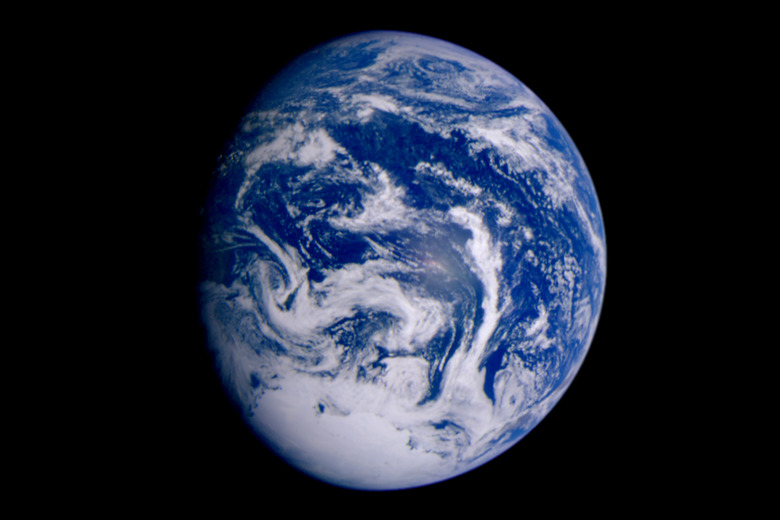Do Winds Always Blow From High Pressure To Low Pressure?
Wind plays an important role in the Earth's weather. The official fastest wind speed of 253 miles per hour occurred in 1996 during Cyclone Olivia in Australia. The unofficial fastest wind, 318 miles per hour as calculated by Doppler radar, happened during a tornado near Oklahoma City in 1999. Understanding what causes wind, especially these destructive winds, starts with understanding how the Sun heats the Earth's surface.
TL;DR (Too Long; Didn't Read)
Wind is generated when air moves from a high pressure system to a low pressure system. The greater the pressure difference, the stronger the wind. Temperature differences cause these pressure differences.
Energy from the Sun
Energy from the Sun
The Sun's energy heats the Earth's atmosphere unevenly. At the equator the heating is relatively consistent, while the Sun's energy spreads out over a larger and larger area as latitude increases. This difference in energy distribution creates global wind patterns.
As the atmosphere heats, the warmer air rises which creates areas of lower pressure. The colder, denser air forming adjacent high pressure systems moves to fill in the space left by the rising warmer air. The warm air cools when it nears the top of the troposphere and sinks back toward the Earth's surface, creating convection currents in the atmosphere.
High pressure weather systems typically result from colder air patterns while low pressure weather systems generally result from warmer air patterns.
Coriolis Effect and Wind Direction
Coriolis Effect and Wind Direction
If the Earth didn't spin, the convection currents in the atmosphere could develop winds that would blow from the poles all the way to the equator. The Earth's rotation around its axis, however, causes the Coriolis effect. The spinning Earth deflects the wind from a straight line into a curve. The stronger the wind, the greater the curve.
In the northern hemisphere the deflection curves to the right. In the southern hemisphere the deflection curves to the left. Another way to consider the direction of the Coriolis effect is from the perspective of an astronaut floating directly above the North pole. A helium balloon released north of the equator would travel in a counterclockwise direction.
If the astronaut were above the South pole instead and the balloon was released south of the equator, the balloon would appear to travel in a clockwise direction.
Trade Winds, Westerlies and Polar Easterlies
Trade Winds, Westerlies and Polar Easterlies
Meanwhile, returning to the equator, the cooling air at the top of the column of rising air is pushed aside and begins to fall back to the Earth's surface. The Coriolis effect twists the rising and falling air nearest the equator into the pattern of wind called the trade winds. In the northern hemisphere the trade winds flow from the northeast to the southwest while in the southern hemisphere the trade winds flow from the southeast to the northwest.
The wind pattern in the mid-latitudes flows in the opposite direction, generally west to east. Weather patterns in the U.S. move from the west coast toward the east coast. These winds are called the westerlies.
Above 60°N and below 60°S latitude the wind tries to blow toward the equator, but the Coriolis effect twists the wind in the pattern called the polar easterlies.
Early explorers learned about these general patterns and used them to explore the world. These wind patterns provided a steady source of propulsion for sailing ships traveling from Europe and Africa to the New World and back again.
Temperature, Air Pressure and Wind
Temperature, Air Pressure and Wind
The pressure differences that make wind happen are caused by differences in temperature. Local wind patterns may seem to violate the global wind patterns, until examined in greater detail.
Land and Sea Breezes
Land areas heat and cool faster than water. During the day, land heats up which heats the air above the land. The warm air rising above the land pulls cooler air in from the water. At night the reverse process occurs.
Water holds temperature longer than land so the warmer air rises, drawing cooler air from over the land. This coastal pattern occurs with locally gradual or slight pressure differentials. Stronger pressure systems negate the slight land-water difference that causes these breezes.
Mountain and Valley Winds
A similar local phenomenon occurs in mountainous areas. Sun heats the ground which heats up the adjacent air. The warmed air rises and colder air farther from the ground moves in, pushing the warmer air up the mountain. At night, ground cooling chills the air adjacent to the ground.
The colder, denser air flows down the mountain. This air flow may become the concentrated breeze in canyons referred to as cold air drainage.
Tornadoes and Hurricanes
The extreme winds of tornadoes and hurricanes also result from pressure differences. The extremely small distance between the high-pressure outer layer and the low-pressure core can generate wind speeds exceeding 200 mph. The Beaufort Wind Scale rates these winds based on observed phenomena. (See References for the Beaufort Wind Scale)
Cite This Article
MLA
Blaettler, Karen G. "Do Winds Always Blow From High Pressure To Low Pressure?" sciencing.com, https://www.sciencing.com/winds-always-blow-high-pressure-low-pressure-23398/. 26 June 2019.
APA
Blaettler, Karen G. (2019, June 26). Do Winds Always Blow From High Pressure To Low Pressure?. sciencing.com. Retrieved from https://www.sciencing.com/winds-always-blow-high-pressure-low-pressure-23398/
Chicago
Blaettler, Karen G. Do Winds Always Blow From High Pressure To Low Pressure? last modified March 24, 2022. https://www.sciencing.com/winds-always-blow-high-pressure-low-pressure-23398/
